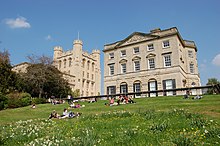Thomas Tyndall
Thomas Tyndall KCB (1723–1794) was a Bristol merchant and banker with extensive slave trade connections.

Tyndall was the son of Onesiphorus Tyndall and Elizabeth Cowles. Tyndall's father had been a founding partner in the Old Bank in Bristol, and Tyndall inherited a considerable legacy on his father's death in 1757. Tyndall also succeeded his father as a partner in the bank.[1][2] Tyndall's uncle William Tyndall was a slave factor in Jamaica, and owned a plantation with his business partner Richard Assheton.[3]
Tyndall commissioned the Royal Fort House in Tyndalls Park in Bristol, now part of the University of Bristol. The house was built around 1767.[4]
Tyndall's daughter Caroline married into another family heavily involved in the slave trade, the Brights.
Bristol University holds a painting of Tyndall and his wife and children, painted by Thomas Beach.[5]
References
- "Tyndall, Onesiphorus (bap. 1689, d. 1757)". Oxford Dictionary of National Biography (online ed.). Oxford University Press. doi:10.1093/ref:odnb/47857. (Subscription or UK public library membership required.)
- "Bristol Past: Early Bristol banks". www.buildinghistory.org. Retrieved 14 June 2020.
- "Summary of Individual | Legacies of British Slave-ownership". www.ucl.ac.uk. Retrieved 14 June 2020.
- "Estates within 2 miles of Bristol | Profits | From America to Bristol | Slavery Routes | Bristol and Transatlantic Slavery | PortCities Bristol". www.discoveringbristol.org.uk. Retrieved 14 June 2020.
- "Thomas Tyndall with Wife and Children". Art UK. Retrieved 14 June 2020.